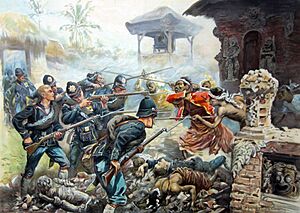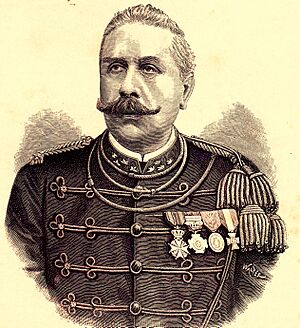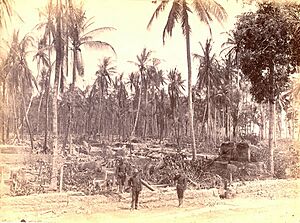Dutch intervention in Lombok and Karangasem facts for kids
Quick facts for kids Dutch intervention in Lombok and Karangasem (1894) |
|||||||
|---|---|---|---|---|---|---|---|
 Attack of the Dutch on a Karangasem stronghold in Lombok in 1894. |
|||||||
|
|||||||
| Belligerents | |||||||
Eastern Sasak Rebels |
|||||||
| Commanders and leaders | |||||||
General-Major P.P.H. van Ham (Second in command) † East Sasak Rebels |
|||||||
| Strength | |||||||
| 2,200 (July expedition) | 12,000 elite troops to quash the rebellion and 500 soliders to against the Dutch | ||||||
| Casualties and losses | |||||||
| 500 (August 1894) 166 (November 1894) |
Thousand | ||||||
The Dutch intervention in Lombok and Karangasem was a military action by the Dutch in 1894. It was part of a series of Dutch actions in and around Bali. These events eventually led to the Dutch taking full control of both Bali and Lombok by the early 1900s.
Contents
Lombok's Early History and Alliances
The island of Lombok was home to the Sasak people, who became Muslims in the 1500s. Some Balinese groups from the Kingdom of Karangasem had control over the western part of Lombok. One of these groups, from Mataram, managed to take over the entire island by 1839. This led to a rich Balinese culture developing on Lombok.
The Dutch wanted to stop English influence in the area. They signed a treaty with Mataram in 1843. Mataram even helped the Dutch during a conflict in Bali in 1849. Because of this help, Mataram was given control over the Karangasem region.
The Sasak Rebellion Begins
Trouble started in 1891 when the Muslim Sasak people in Eastern Lombok rebelled. They rose up against their Balinese ruler, Anak Agung Gde Ngurah Karangasem. There had been other rebellions in 1855 and 1871, but the Mataram ruler had stopped them.
This new rebellion began when the ruler asked for thousands of Sasak troops. He wanted them to attack the Klungkung kingdom in Bali. His goal was to become the main ruler of all Bali.
On August 25, 1891, the ruler's son, Anak Agung Ketut Karangasem, led 8,000 troops against the rebellious town of Praya. Later, on September 8, another 3,000 troops were sent. The royal army faced difficulties. So, the ruler asked for help from his ally, Anak Agung Gde Jelantik of Karangasem. Jelantik sent 1,200 special troops to help stop the rebellion.
The war lasted from 1891 to 1894. The Mataram army was very strong, even having two modern warships. They managed to take over the rebellious villages. They also surrounded the last Sasak fighters.
On February 20, 1894, the Sasak people officially asked the Dutch for help. The Dutch saw this as a chance to expand their control in the East Indies. They decided to support the Sasak people. The Dutch then started to block weapons and supplies from reaching the Balinese rulers from Singapore.
Dutch Military Action (July 1894)
The blockade was not enough. The Dutch demanded that Mataram surrender, but Mataram refused. In July 1894, the Dutch decided to send a military force to remove the Mataram ruler.
Three ships, the Prins Hendrik, the Koningin Emma, and the Tromp, sailed from Batavia. They carried 107 officers, 1,320 European soldiers, 948 local soldiers, and 386 horses.
Surprise Attack at Mayura Palace
In August 1894, the Balinese decided to fight back against the Dutch. On August 25, 1894, they launched a surprise night attack on the Dutch military camp. This camp was near Mayura Palace in Cakranegara.
The Balinese killed over 500 Dutch soldiers, sailors, and workers. General P.P.H. van Ham, who was the second-in-command of the Dutch force, was among those killed. The Dutch soldiers had to retreat and build strong defenses on the coast.
Dutch Send More Troops
The Dutch returned with many more soldiers, led by General Vetter. They attacked Mataram and completely destroyed it. On November 8, 1894, they used artillery to heavily bomb the Balinese positions at Cakranegara. The palace was destroyed, and about 2,000 Balinese people were killed. The Dutch lost 166 men.
By the end of November 1894, the Dutch had crushed the Balinese forces. Thousands of Balinese had died, and they finally surrendered.
Aftermath and Dutch Control
Lombok and Karangasem became part of the Dutch East Indies. They were then managed from Bali. Gusti Gede Jelantik was appointed as a Dutch leader in 1894 and ruled until 1902.
The Dutch took the royal treasure from Lombok. This included 230 kilograms (about 507 pounds) of gold and 7,000 kilograms (about 15,432 pounds) of silver, along with valuable jewelry. Soon after, other areas like Bangli and Gianyar also accepted Dutch rule. However, southern Bali continued to resist until another Dutch intervention in 1906.
Images for kids
See also





